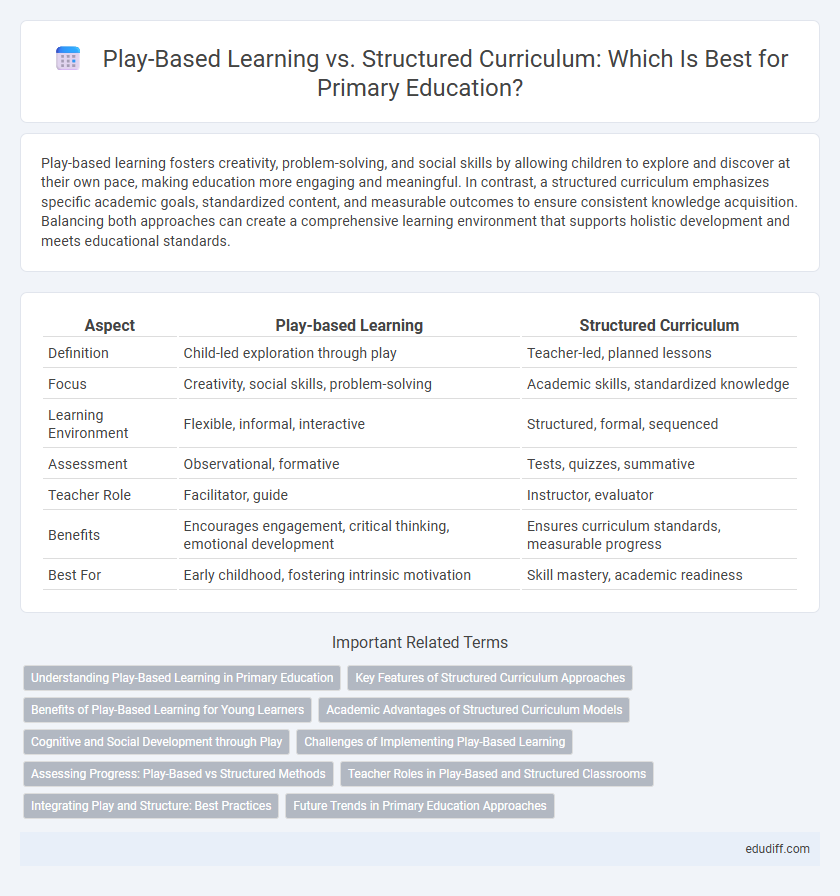Play-based learning fosters creativity, problem-solving, and social skills by allowing children to explore and discover at their own pace, making education more engaging and meaningful. In contrast, a structured curriculum emphasizes specific academic goals, standardized content, and measurable outcomes to ensure consistent knowledge acquisition. Balancing both approaches can create a comprehensive learning environment that supports holistic development and meets educational standards.
Table of Comparison
| Aspect | Play-based Learning | Structured Curriculum |
|---|---|---|
| Definition | Child-led exploration through play | Teacher-led, planned lessons |
| Focus | Creativity, social skills, problem-solving | Academic skills, standardized knowledge |
| Learning Environment | Flexible, informal, interactive | Structured, formal, sequenced |
| Assessment | Observational, formative | Tests, quizzes, summative |
| Teacher Role | Facilitator, guide | Instructor, evaluator |
| Benefits | Encourages engagement, critical thinking, emotional development | Ensures curriculum standards, measurable progress |
| Best For | Early childhood, fostering intrinsic motivation | Skill mastery, academic readiness |
Understanding Play-Based Learning in Primary Education
Play-based learning in primary education prioritizes child-centered activities that foster creativity, problem-solving, and social skills through exploration and hands-on experiences. Research shows this approach enhances cognitive development by allowing children to construct knowledge in meaningful contexts, contrasting with the rigid framework of structured curricula. Implementing play-based strategies supports engagement and intrinsic motivation, crucial for foundational literacy and numeracy skills development.
Key Features of Structured Curriculum Approaches
Structured curriculum approaches in primary education prioritize predefined learning objectives, standardized assessment methods, and sequenced content delivery to ensure consistent academic progress. These methods emphasize teacher-led instruction, clear benchmarks, and measurable outcomes that align with national education standards. This approach fosters skill mastery through repetition, systematic reinforcement, and uniformity across classrooms.
Benefits of Play-Based Learning for Young Learners
Play-based learning fosters creativity, critical thinking, and social skills in young learners by encouraging exploration and hands-on experiences. It supports cognitive development and emotional resilience, helping children to build problem-solving abilities within natural contexts. Research indicates that play-based approaches enhance engagement and motivation, leading to improved academic outcomes compared to strictly structured curricula.
Academic Advantages of Structured Curriculum Models
Structured curriculum models enhance academic outcomes by providing a clear, sequential framework that aligns learning objectives with measurable standards. This approach supports skill mastery through systematic instruction and continuous assessment, promoting higher proficiency in foundational subjects like mathematics and literacy. Consistent exposure to targeted content in structured settings fosters cognitive development, preparing students for advanced academic challenges.
Cognitive and Social Development through Play
Play-based learning fosters cognitive development by encouraging creativity, problem-solving, and critical thinking through exploratory activities that adapt to a child's interests and pace. Structured curriculum provides targeted skill-building and measurable learning outcomes, often emphasizing academic readiness with clear objectives and assessments. Balancing play-based approaches with structured elements enhances social skills such as cooperation, communication, and empathy while simultaneously supporting cognitive growth and academic achievement.
Challenges of Implementing Play-Based Learning
Implementing play-based learning in primary education faces challenges such as limited teacher training, insufficient resources, and curriculum constraints emphasizing standardized testing. Balancing child-led play with learning objectives requires careful planning to ensure developmental goals are met without sacrificing creativity. Resistance from stakeholders used to traditional methods can also hinder adoption of play-based approaches in structured educational systems.
Assessing Progress: Play-Based vs Structured Methods
Assessing progress in play-based learning emphasizes observation of children's social interactions, problem-solving abilities, and creativity, providing qualitative insights into developmental milestones. In contrast, structured curriculum assessments rely on standardized tests and measurable academic benchmarks to evaluate specific skills in literacy, numeracy, and cognitive development. Combining both methods offers a comprehensive understanding of a child's growth by capturing both holistic development and skill acquisition.
Teacher Roles in Play-Based and Structured Classrooms
Teacher roles in play-based classrooms emphasize facilitating exploration, guiding child-led activities, and fostering creativity through responsive interactions. In structured curriculum settings, teachers focus on delivering predefined content, managing classroom routines, and assessing student progress against standardized benchmarks. Effective educators adapt their approaches to balance student autonomy with instructional goals, optimizing learning outcomes.
Integrating Play and Structure: Best Practices
Integrating play-based learning with a structured curriculum enhances cognitive development and social skills in early childhood education. Effective strategies include using thematic units that combine exploratory play with targeted learning objectives, ensuring alignment with educational standards while fostering creativity. Teachers facilitate guided play activities that encourage problem-solving and collaboration, balancing freedom and structure to maximize student engagement and learning outcomes.
Future Trends in Primary Education Approaches
Emerging trends in primary education emphasize a balanced integration of play-based learning and structured curriculum to foster cognitive, social, and emotional development. Advances in digital technology and neuroscience research support personalized, adaptive learning environments combining interactive play with targeted instructional frameworks. Future models prioritize flexibility, creativity, and critical thinking skills to prepare students for complex, evolving global challenges.
Play-based Learning vs Structured Curriculum Infographic

 edudiff.com
edudiff.com